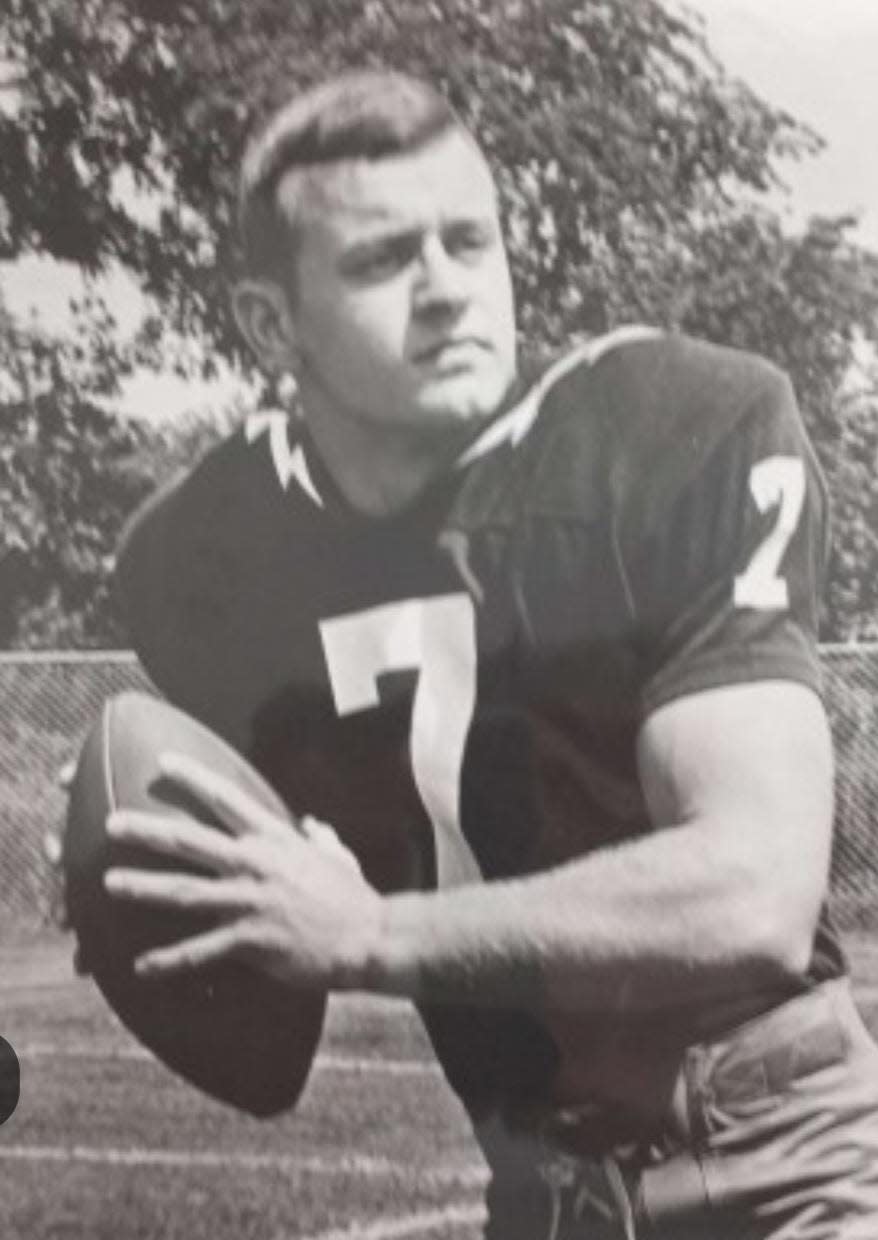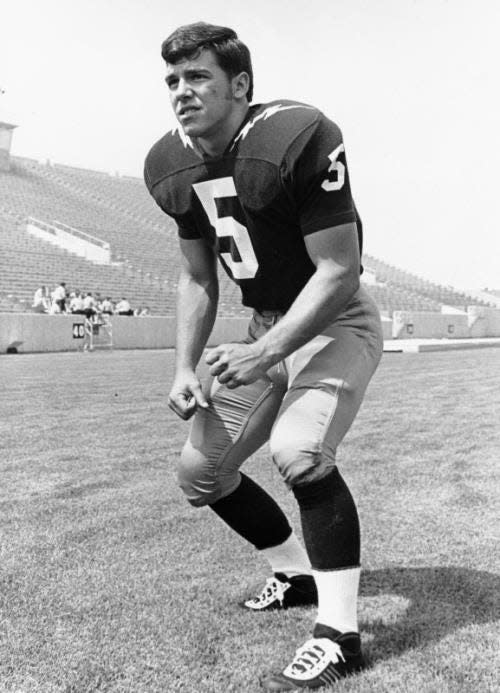May 4 shootings leave deep impressions on Kent State QB from Canton and young Nick Saban
It's not much of a stretch to say everybody in the country in 1969 knew somebody in harm's way in Vietnam.
The count of United States soldiers in Southeast Asia that year approached half a million.
It's a stretch to say life went on as normal back home. In some ways, it seemed to; in many ways, not.
Some popular songs from 1969 (The Boxer; Bad Moon Rising; In the Year 2525) carried heavy themes. Most (Sugar Sugar; Honky Tonk Women; Ob-Bla-Di, Ob-La-Da) didn't.

TV variety shows featuring Red Skelton, Carol Burnett, Dean Martin and Johnny Cash chased No. 1 Rowan & Martin's Laugh-In.
The sports world was full of scene-setting memories.
Nick Weatherspoon vs. Luke Witte became one of the all-time things in Stark County basketball.
On New Year's Day, 1969, Ohio State won a national football championship by beating USC in the Rose Bowl.
Buckeye defensive end Nick Roman exemplified how the tentacles of Vietnam touched people one way or another.
Coming out of Canton McKinley High School, believing he would get drafted by the military, Roman plotted a more agreeable course toward possible war-time duty, enrolling in the Reserve Officers Training Corps (ROTC) at Ohio State.
Roman started for Woody Hayes' Buckeyes in 1967 and 1969 but missed the 1968 season after mangling a knee on an ROTC obstacle course.
Kent State planned for a new stadium, perhaps on campus, that might eventually seat 50,000.

The new stadium instead arose off campus, initially with room for about 25,000, and opened on Sept. 13, 1969, with a 24-14 win over a Dayton team coached by future NFL giant John McVay.
The stadium wasn't finished. On game days, teams dressed in the campus basketball arena, bused a mile to the stadium, and used men's rooms for halftime meetings.
Looking back first story in series: A flash in time: The unlikely saga of Kent State's greatest football team, Part 1

Ted Bowersox, a Canton McKinley graduate, was a sophomore quarterback for the Golden Flashes.
"I was still home in Canton in August," Bowersox recalls. "Colonial Lanes was a gathering spot, and I was there with my friend Mark Sokol. Jimmy and the Soul Blazers were playing."
He met a girl named Mary Kay. They danced and talked, but it was a bad time to start a relationship. Ted moved back to his Kent State dorm the next day for the start of football practice.
Dover's Steve Trustdorf beat out Bowersox and started the Dayton game and then games on Sept. 20 and Sept 27.

On Sept. 28, James Gang headlined a "Free Festival of Life" concert at Fred Fuller Park in Kent, where the lineup included The Measles, Damnation of Adam Blessing, and Glass Harp.
Six days later, Bowersox started in place of Trustdorf against Buffalo.
"My first play was a handoff to Don Nottingham," Bowersox recalls. "I missed the handoff."
He tucked the ball and ran a long way. He made four more starts in a 5-5 season that ended with a 17-14 upset of Miami on Nov. 15.
On Nov. 16, Cleveland beat Pittsburgh en route to the NFL Championship Game. Had the Browns defeated the Vikings there, they would have faced Kansas City in Super Bowl IV. Instead, Alliance's Len Dawson led the Chiefs past Minnesota.
Basketball season replaced football. In the 1970 NBA draft, on March 23, Bob Lanier, Rudy Tomjanovich and Pete Maravich were picked 1-2-3; Kent State's Tom Lagodich, from Canton South, went 143rd overall to the expansion Cleveland Cavaliers.
On May 1, Cleveland Indians ace Sam McDowell took a 3-2 lead into the ninth, but the Kansas City Royals won in 17 innings. The game lasted five hours.
It was the day the trouble began at Kent State.
May 1 was a Friday. About 500 people gathered on the campus commons to protest an apparent expansion of the war. Later, downtown violence prompted an early closing of bars.

As tensions heightened on May 2, Kent Mayor LeRoy Satrom asked Governor James Rhodes to send in the National Guard. By the time the Guard arrived around 10 p.m., Kent State's ROTC building had burned to the ground.
In Kent for a May 3 press conference, Rhodes blamed "people who just move from one campus to the other and terrorize the community. They're worse than the brown shirts and the communist element and also the night riders and the vigilantes."

Helicopters maneuvered above campus as National Guardsmen and police spread out. After sundown, Guardsmen used tear gas to scatter the crowd from the commons.
The Guard resumed positions on Monday morning, May 4. An estimated 3,000 people repopulated the commons. A victory bell used after football games rang and inspired a dull roar.

Around noon, bullhorn warnings to disperse heightened a clamor the word "cacopohony" only begins to describe, leading to an inexplicable chapter in American history.
At 12:24 p.m., Guardsmen moving up a hill turned and opened fire on an unarmed crowd.

Students Allison Krause, 19; Bill Schroeder, 19; Jeffrey Miller, 20, and Sandra Scheurer, 20, all died, shot in the proximity of the architecture building, within view of the ROTC building rubble.
In his 2005 autobiography, Nick Saban, then a freshman, said he attended an 11 a.m. English class before joining a friend for lunch on campus, with plans to "wander by the rally out of curiosity."

The rest of the excerpt:
"As we made our way out of the cafeteria, someone ran up to us, hysterical, saying that people had been shot.
"We quickly made our way to the quad area where the rally was taking place, but we were prevented from getting too close. Smoke and sirens filled the air as ambulances dashed across the grass.
"I could see people lying on the ground, all covered in blood. … My heart sank into my chest."

A documentary released 30 years later condensed the incomprehensible into the title: "Kent State, The Day the War Came Home."
A face in the May 4 crowd was Chrissie Hynde, a Kent State freshman from Akron's Firestone High School.

In her 2015 autobiography, "Reckless: My Life As A Pretender," Hynde recalled a sound like fireworks that turned out to be gunfire.
"The Guardsmen themselves looked stunned," Hynde wrote. "We looked at them and they looked at us. They were just kids, 19 years old, like us."
Saban was 18, a student in one of Allison Krause's classes.

In an recent interview with The Canton Repository, he said it was much to digest.
"I was just a kid coming from West Virginia who had been working at my dad's service station station from the time I was 11," he said "It was my freshman year. I finished the semester from home."
Bowersox forgot about being Kent State's quarterback of the future. As he noted in a recent interview, "The whole world came crashing down."
On May 4, Bowersox wound up near the scene captured in a famous photograph of a girl screaming above Jeffrey Miller's body.

"I was on my way back to my dorm," Bowersox said. "I'm coming over the hill next to the architecture building.
"I was standing right by the blood. I'm standing there looking at it.
"You could smell the smoke in the air. I won't go into the whole picture.
"A guy from my dorm got shot. It sounds strange, but I stopped for a second, right at the corner of what was our upper practice field, and tried to capture the moment and everything it meant.
"They sent everybody home … get out of here … we're done."

He packed and drove home to Canton that same Monday.

"Mom and dad were in New Orleans at a convention," Bowersox said. "When I pulled into our driveway, Bob Sylvester was sitting on the front doorstep. We talked for a long time. I told him everything I saw."
Wishing not to spend the evening alone, he phoned the girl he met nine months earlier at Colonial Lanes.
"We wound up going to Taggart's," he said. "We had ice cream and we talked.
"We went out the next 17 nights in a row. We've been 'dating' ever since."

Football practice for Kent State's 1970 season started three months after the shootings under third-year head coach Dave Puddington, a decorated U.S. Navy pilot during the Korean War.
"The football team was the first group back on campus," Bowersox said. "Everybody wondered what the atmosphere was going to be like.
"They decided to print up blue and white T-shirts that said 'Kent State, we care.' They wanted us to wear them around campus.
"Dave thought the football team could set a solidifying tone after all that happened. The team felt a little like, maybe everybody doesn't agree. Are we supporting the war? Are we not supporting the war?
"George Austin, a player from McKinley, was maybe more liberal than some people. He wasn't in concurrence. That whole thing started to take a different, awkward shape.
"The coach wore a flat-top. I had a little bit of hair down to my ears. Dave came up and said, 'I think you might be due for a haircut there, Teddy.' I said, 'I don't think so. What do you mean?'
"A lot of players eventually turned on the coach.
"I bet you 95% of us, including myself, didn't know he had been in the Korean War."
Fred Blosser, from Dalton, walked on at Michigan in 1967 and transferred to Kent State in 1968.
Blosser became Kent State's starting center, twice making first team, All-Mid-American Conference.
"It was a tumultuous time going into the 1970 season," he said. "There was a lot of negativity on campus."
The new stadium hosted home games in 1969 but wasn't dedicated until 1970, four months after the shootings. The 1970 home opener brought a 24-14 loss to Ohio. The Golden Flashes soon lost a road game to Bowling Green 44-0.
Puddington resigned shortly after a 3-7 season, citing "a prevailing contagious negativism on campus and in the community."
NEXT: The new head coach, Don James, went 3-8 in his first year. A momentous season and record crowds seemed highly unlikely.
This article originally appeared on The Repository: Football freshman Nick Saban talks May 4 1970 Kent State shootings
